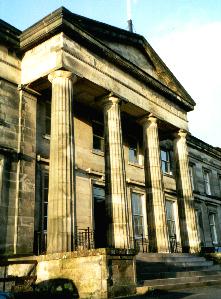
The complete text, should you wish all the details, can be accessed from the Bowie Index Link at the bottom of the page.
2. The Bowie family.
3. The story of William Bowie.
4. The story of Helen Bowie/Philp.
5. David and Helen emigrate to New Zealand.
6. Early days in New Zealand.
7. The Philp children.
8. Comments about the research.
Alexander Bowie was not a native of Stirling and only came to the Burgh around 1802. It has been very
difficult to establish his genealogy but accurate evidence points firmly to his birth in the village of
Muthill, in Perthshire, as being his birth place in 1766.
The first time that he appears in the Town records is on the 3rd August 1804 when he applied to join the
Incorporation of Mechanics as a Wright, This was one of the means of regulating the labour force by
ensuring that standards of workmanship were maintained.
On the 3rd of February 1807, when the prison project was well under way, Bowie again applied to the
Incorporation of Mechanics, to be recognised, this time, as a Mason.
February 1808 saw a major change in Bowie’s life when he married Margaret Hill the daughter of
Alexander Hill a well known local Maltster, Burgess, and Guild Brother and the new family connections
gave Bowie the social standing in the town of Stirling that his earlier life lacked. The Hills were one of the
main families of the town with marriage links tying them to the Forresters of Craigannet, Walter Glas of
Sheriffmuirlands and the Gillies family of Gormyre.
In 1808 Bowie, took advantage of these family connections, in particular his relationship to Alexander Hill
when he applied to become a Burgess.
During the next five or six years Bowie appears in the Burgh records as undertaking a number of small
pieces of work. He developed his building skills when he bought ground in Allan Park on which he then
built Georgian-style houses, characterised by a grey ashlar sandstone finish rather than the brown
whinstone , quarried locally and typical of the town architecture.
In many ways the story of the Bowie family is a tragic one. Nine months after Alexander Bowie married
Margaret Hill their first child William was born. After that Margaret gave birth with amazing regularity
almost every two years until 1825. In all the Bowies had ten children.
Of the ten children the first two Alexander's and David died in infancy. Little is known about Mathew who
died in 1829 at the age of fifteen and Alexander who died in 1840 at age 20. Margaret died unmarried in
1845 also age 20 and her sister Christian or Christine died in childbirth about the same time having been
married for only a year. Robert, something of a problem to the family, was last heard of heading for
Jamaica. His fate is unknown.
The greatest amount of surviving information is that about William and Helen.
Margaret Bowie, the wife of Alexander, died of what would appear to be Tuberculosis in 1826 leaving
Bowie to care for seven children. Bowie himself died in 1829 leaving the extended family to care for the
surviving five children.
The decade 1820 to 1829 was truly a tragic one for the Bowie family. At the beginning of that period the
family consisted of Father, Mother and five children with two more born during that time. By the end of the
decade only five orphans survived.
Return to the top of the page.
Educationally the highest achiever of the Bowie children William attended The Grammar School at
Stirling and matriculated at the University of Glasgow at age 14. After two years studying there, he
enrolled at the University of Edinburgh in 1825 to study Medicine. He graduated in 1827 (aged 19) as a
Licentiate of the Royal College of Surgeons, studying under the famous Dr Robert Knox. William missed,
by six months, the Burke and Hare situation that embroiled Knox in 1828.
In August 1827 William took a job in Portpatrick as the local Surgeon but his health failed after only seven
months and he came home to Stirling in March 1828, dying, from tuberculosis, at age 20 in November of that year as
had his mother only two years earlier.
This story is documented in detail from the letters from both father and son. archived in Canada. It is located in the Appendix to the full Bowie/Philp story.
Return to the top of the page.
With the other nine Bowie children dying at a young age Helen’s longevity, dying as she did at age 84, is
exceptional and undoubtedly reflects her totally different life situation.
Brought up after her father’s death by her Mother’s maiden Aunt, Helen appears to have been a teacher.
She remained unmarried until July 1856 when, at the age of 33, she married David Philp a teller in the
Bank of Scotland in Perth. After a honeymoon in Paris they briefly settled in a house in Perth.
In March 1857 David made a decision that was to influence their lives dramatically. He left the Bank of
Scotland, where he had worked since 1836, to become Manager of the recently opened Callendar branch of the Edinburgh and Glasgow Bank. Sadly this
Bank only survived for a short while and in May 1858 a Bank crash was narrowly averted by a Clydesdale
Bank take-over.
This business does not seem to have lasted more than a year and, in 1863 the momentous decision to
emigrate to New Zealand was made by David and Helen.
Return to the top of the page.
The voyage of the Queen of Beauty, well documented in the main the story, was fairly uneventful —apart
from a wild storm in the ‘roaring forties’ and the ship being stopped and boarded when it was off Rio De
Janeiro, by the infamous Confederate ship the ‘Alabama’ under the command of the equally infamous
Captain Raphael Semmes.
The Queen of Beauty arrived in Auckland on the 9th of August 1863 after a voyage of 96 days. The
passenger list printed the next day in an Auckland newspaper indicates that David, Helen and family
travelled steerage and not in one of the cabins. Another fact that surely is a reflection of their reduced
circumstances before leaving Scotland.
Return to the top of the page.
A house had been arranged for David and Helen through the contacts of Helen’s cousin’s husband in
London and a few months later we find David in the employment of the recently formed Bank of Auckland.
He eventually became its branch manager at Onehunga, a thriving new port close to Auckland. In 1864
their fourth child Agnes Helen was born.
History sadly repeated itself and again the couple were caught up in a bank crash when the Bank of
Auckland went into liquidation in 1867. This, in turn, led to yet another major career move for David
when he became a Mining Manager in the frontier town of Shortland where the Thames gold field was just
opening up. Helen and the children remained in Onehunga until David had built a wooden house on
Mackay Street. They subsequently joined him in 1868.
With the descriptions of Shortland emphasising the mud and the incessant noise of machinery we cannot
help but contrast the family’s lifestyle there with that of the elegance of their previous Bowie or ‘Greek’
Thomson buildings. They remained in Shortland until the late 1870s when David retired and the family
returned again to Auckland where David died in 1883 at the age of 63. Return to the top of the page.
His son Roslyn Foster Bowie Philp, Alexander Bowie’s great-grandson, was knighted in 1958 for his community work and services to the Queensland Bar. His Great Grandfather Alexander Bowie, a definite social climber in Stirling, would, undoubtedly, have enjoyed this event.
His descendants currently live in Queensland.
It has been almost impossible to research Andrew’s life. He certainly married—moved to
Australia and then back to New Zealand—and none of his children seem to have had any family.
Return to the top of the page.
1. Bowie the Builder
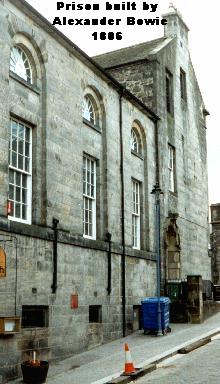 During the years 1806-1808 Bowie was engaged with Thomas Traquair, a local joiner in the building of the
new prison attached to the Tollbooth. Considering Bowie’s standing in the Burgh as a Wright and Traquair
a Burgess it is likely that the latter was the senior partner in the venture.
During the years 1806-1808 Bowie was engaged with Thomas Traquair, a local joiner in the building of the
new prison attached to the Tollbooth. Considering Bowie’s standing in the Burgh as a Wright and Traquair
a Burgess it is likely that the latter was the senior partner in the venture.
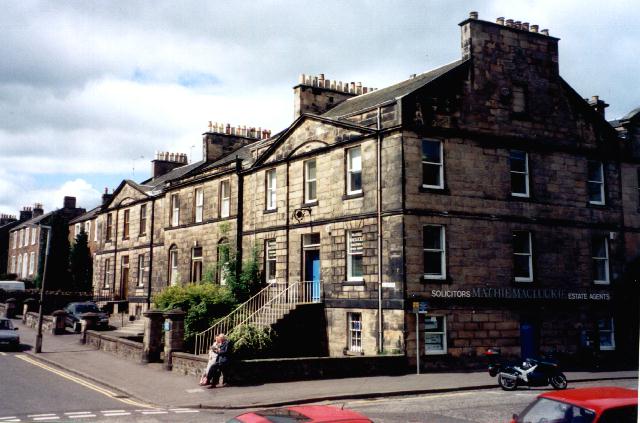 In Allan Park, Bowie himself owned and developed a single detached house at No. 11 and two balanced
blocks of terraced houses on both sides of the road ( Nos. 1—9 and 2—6) . These he built as a speculative
enterprise and they show a utilitarianism not usually associated with Georgian architecture. Clearly he was
building to a budget. He located his stoneyard on his land on, and behind, the property that is now
Haddow’s off-licence in Dumbarton Rd. The distinctive stone used in all his sandstone buildings, he
quarried from Thorneydyke quarry in the hills above Dunipace and transported it to Stirling for finishing .
In Allan Park, Bowie himself owned and developed a single detached house at No. 11 and two balanced
blocks of terraced houses on both sides of the road ( Nos. 1—9 and 2—6) . These he built as a speculative
enterprise and they show a utilitarianism not usually associated with Georgian architecture. Clearly he was
building to a budget. He located his stoneyard on his land on, and behind, the property that is now
Haddow’s off-licence in Dumbarton Rd. The distinctive stone used in all his sandstone buildings, he
quarried from Thorneydyke quarry in the hills above Dunipace and transported it to Stirling for finishing .
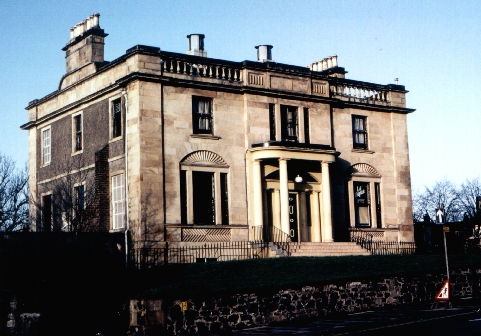 His other great project, undertaken for his wife’s uncle, Robert Gillies tanner and sometime Provost of
Stirling, was the building of Craigs House at the foot of The Craigs and opposite the Tannery. This project
is probably the most graceful of Bowie’s houses and has all the usual architectural features associated with
the grander style of Georgian house. Clearly, to Robert Gillies money was not a problem and one assumes
that the elaborate appearance of the building did wonders for Bowie’s image as a builder/architect.
His other great project, undertaken for his wife’s uncle, Robert Gillies tanner and sometime Provost of
Stirling, was the building of Craigs House at the foot of The Craigs and opposite the Tannery. This project
is probably the most graceful of Bowie’s houses and has all the usual architectural features associated with
the grander style of Georgian house. Clearly, to Robert Gillies money was not a problem and one assumes
that the elaborate appearance of the building did wonders for Bowie’s image as a builder/architect.
 Undoubtedly the most spectacular public building built by Bowie was the new Stirling branch of the
Commercial Bank in Spittal Street. This building, extended from Bowie’s original is the present Health
Board office and formerly was the first Stirling Royal Infirmary. It was commissioned by the Bank’s Board
of Directors in Edinburgh. The minute for 21st June 1827 agrees to ‘ accept the offer by Messrs Thomas
Traquair and Alexander Bowie for building the Bank’s House in Stirling' at a price of £1960.’
Undoubtedly the most spectacular public building built by Bowie was the new Stirling branch of the
Commercial Bank in Spittal Street. This building, extended from Bowie’s original is the present Health
Board office and formerly was the first Stirling Royal Infirmary. It was commissioned by the Bank’s Board
of Directors in Edinburgh. The minute for 21st June 1827 agrees to ‘ accept the offer by Messrs Thomas
Traquair and Alexander Bowie for building the Bank’s House in Stirling' at a price of £1960.’
![]()
2. The Bowie Family
The Bowie Children
Name Date of Birth Date of Death Comments
William 30th November 1808 18th November 1828 Just 7 months before his father's death
Alexander September 1810 Not known Died as an infant
Robert 23rd August 1812 After 1831 Died abroad somewhere
Mathew 20th September 1814 20th December 1829 Only 5 months after his father
Christian 19th June 1816 30th April 1844 In Childbirth--Married name McDonald
Alexander 10th January 1818 1818 Died as a baby
Alexander 24th January 1819 29th February 1840 Aged 21. Third attempt at an Alexander
David Will 5th July 1820 30th June 1825 While Bowie's wife was carrying Margaret
Helen 16th June 1823 18th November 1907 Died in Sydney, Australia Aged 84
Margaret 16th November 1825 1846 Aged 21 Death of Bowie's wife
![]()
3. The Story of William Bowie
![]()
4. The Story of Helen Bowie/Philp (1823-1907)
Pictured in Australia in 1903
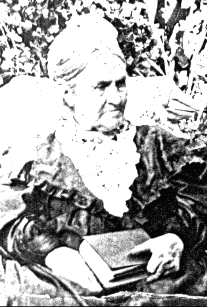
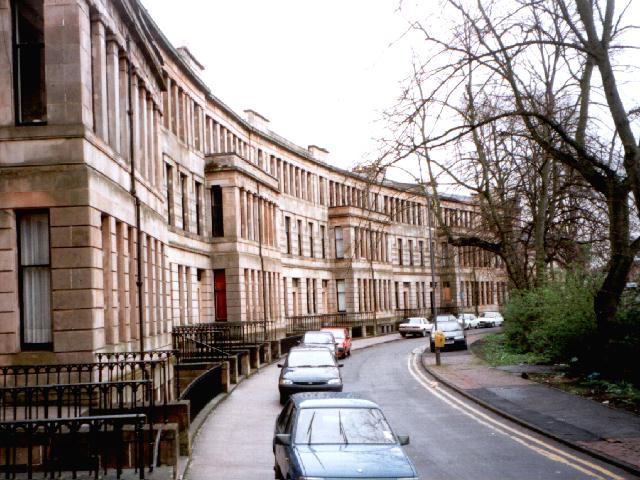 David and Helen moved with the Clydesdale Bank and stayed in a newly built ‘Greek’ Thomson house in
Walmer Crescent Glasgow. David left the Clydesdale Bank in 1862 to start the shawl manufacturing
business of Hutton Philp and Co with an address at 1 Princes Square.
David and Helen moved with the Clydesdale Bank and stayed in a newly built ‘Greek’ Thomson house in
Walmer Crescent Glasgow. David left the Clydesdale Bank in 1862 to start the shawl manufacturing
business of Hutton Philp and Co with an address at 1 Princes Square.
![]()
5. David and Helen Emigrate to New Zealand
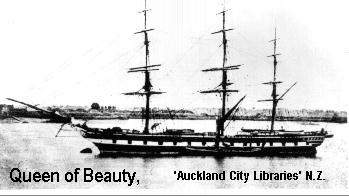 On the 4th of May 1863 the family, David, Helen, Margaret (4 years), James (3 years) and Andrew (10
months), set sail from London on board the Clipper ship ‘Queen of Beauty’. The round of leave-taking to
elderly aunts and other family members must have been painful and the decision surely reflects the
desperate straits into which the Philp fortunes had fallen. A desperate situation that called for a drastic
solution.
On the 4th of May 1863 the family, David, Helen, Margaret (4 years), James (3 years) and Andrew (10
months), set sail from London on board the Clipper ship ‘Queen of Beauty’. The round of leave-taking to
elderly aunts and other family members must have been painful and the decision surely reflects the
desperate straits into which the Philp fortunes had fallen. A desperate situation that called for a drastic
solution.
![]()
6. Early Days in New Zealand
![]()
7. The Philp Children
Margaret
Pictured in 1914
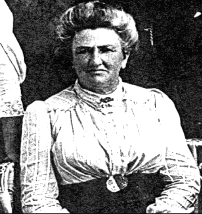 The eldest of David and Helen’s children married Harry Carse a noted New Zealand plant
collector. The Herbarium near Christchurch is named after him. They had four children and all their
descendants continued to live in New Zealand except the line through Harry Carse junior who returned to
Scotland. Present day descendants live in Dysart.
The eldest of David and Helen’s children married Harry Carse a noted New Zealand plant
collector. The Herbarium near Christchurch is named after him. They had four children and all their
descendants continued to live in New Zealand except the line through Harry Carse junior who returned to
Scotland. Present day descendants live in Dysart.
![]()
James
Pictured in 1926 holding his first Grand-daughter Heather Junner
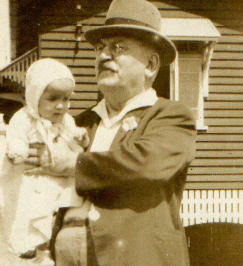 At an early age James became a journalist and worked for both Thames and Auckland newspapers.
In 1888 he moved to Sydney and there founded the first Chinese newspaper. He subsequently moved to
At an early age James became a journalist and worked for both Thames and Auckland newspapers.
In 1888 he moved to Sydney and there founded the first Chinese newspaper. He subsequently moved to
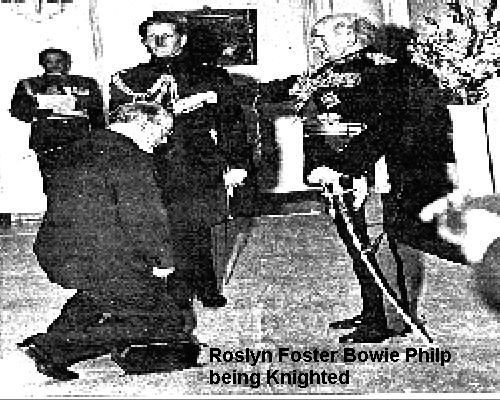 Brisbane to the ‘Courier’. He was also the author of a number of books.
Brisbane to the ‘Courier’. He was also the author of a number of books.
James died in 1935 in Brisbane.
![]()
Andrew.
![]()
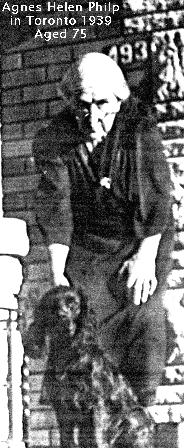
Agnes Helen
Pictured in Toronto in 1939, aged 75
Married a Canadian, Thomas Wetherald, in Australia and, after nursing Helen at her death
in Sydney in 1908, she subsequently moved with her husband and son, to Canada in 1912. Their
descendants, also with the Bowie name, presently live in Toronto.![]()
The Kings Park Community Council of the time brought Bob McCutcheon, Peter Aitken and myself together resulting in the two publications‘ Kings Park’ and ‘The Homesteads’ under the series title Notes for a New History of Stirling.
At this time the first draft of the Bowie story, as we knew it then, was written up. It ended by saying that the beginning and the end of that story might never be clear because we could not find where Bowie originally came from or what became of his descendants. Because of a brief note in the local paper we were aware that Helen and David planned to emigrate to Shortland in New Zealand but the Embassy assured us that no such place existed.
The internet contact with Bowie’s descendants has unearthed an amazing number of original letters dating from 1811 to Alexander Bowie and various members of his extended family. Almost all of this material must have been collected by Helen and taken by her to New Zealand in the first instance and subsequently on to Australia. Eventually most of it found its way to Canada with the youngest daughter.
The discovery of this material has given remarkable insight into the more personal aspects of the family and I am deeply grateful to both the family members and the Internet genealogists in New Zealand and Australia who have made this research possible.
| LINK TO THE DETAILED GENEALOGY OF THE BOWIE/PHILP STORY |  |
| LINK TO THE INDEX TO THE FULL BOWIE/PHILP STORY |  |
Return to the top of the page.
